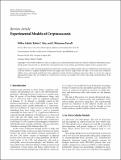Files in this item
Experimental models of cryptococcosis
Item metadata
| dc.contributor.author | Sabiiti, Wilber | |
| dc.contributor.author | May, Robin C | |
| dc.contributor.author | Pursall, E Rhiannon | |
| dc.date.accessioned | 2018-10-17T08:30:06Z | |
| dc.date.available | 2018-10-17T08:30:06Z | |
| dc.date.issued | 2012 | |
| dc.identifier | 199048908 | |
| dc.identifier | be30a2f5-fd0b-446a-a324-dfdff77f022a | |
| dc.identifier | 22007224 | |
| dc.identifier | 84855414153 | |
| dc.identifier.citation | Sabiiti , W , May , R C & Pursall , E R 2012 , ' Experimental models of cryptococcosis ' , International Journal of Microbiology , vol. 2012 , 626745 . https://doi.org/10.1155/2012/626745 | en |
| dc.identifier.issn | 1687-918X | |
| dc.identifier.uri | https://hdl.handle.net/10023/16247 | |
| dc.description.abstract | Cryptococcosis is a life-threatening fungal disease that infects around one million people each year. Establishment and progression of disease involves a complex interplay between the fungus and a diverse range of host cell types. Over recent years, numerous cellular, tissue, and animal models have been exploited to probe this host-pathogen interaction. Here we review the range of experimental models that are available for cryptococcosis research and compare the relative advantages and limitations of the different systems. | |
| dc.format.extent | 1383304 | |
| dc.language.iso | eng | |
| dc.relation.ispartof | International Journal of Microbiology | en |
| dc.rights | Copyright © 2012 Wilber Sabiiti et al. This is an open access article distributed under the Creative Commons Attribution License, which permits unrestricted use, distribution, and reproduction in any medium, provided the original work is properly cited. | en |
| dc.subject | QR180 Immunology | en |
| dc.subject.lcc | QR180 | en |
| dc.title | Experimental models of cryptococcosis | en |
| dc.type | Journal item | en |
| dc.contributor.institution | University of St Andrews.School of Medicine | en |
| dc.contributor.institution | University of St Andrews.Gillespie Group | en |
| dc.identifier.doi | 10.1155/2012/626745 | |
| dc.description.status | Peer reviewed | en |
This item appears in the following Collection(s)
Items in the St Andrews Research Repository are protected by copyright, with all rights reserved, unless otherwise indicated.

